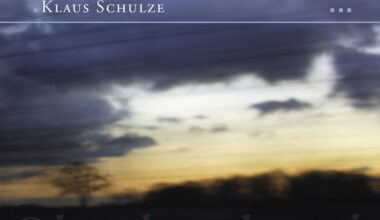Float On

The engine room of ‘The Ship’ is Brian Eno’s discovery that his voice can now hit previously unfathomable depths. So what we get on the 20-plus minute opening title track of this album is a stentorian vox regularly exercising that low C, rattling the glassware in a series of simple melodic lines. It’s a sound that resonates and undulates unsteadily as it takes a bathyscaphe trip down to its murky seabed at the end of each stanza.
Eno’s vocals are predictable because he sings the same tune over and over, four white notes from the key of C, but they waver and shift and always resolve on that timber-shivering low note, while another voice, rendered into a processed and crackly drone, harmonises throughout. It’s peculiarly affecting and pleasant.
The track has echoes of Gavin Bryars’ saintly ‘Jesus’ Blood Never Failed Me Yet’, a live performance of which was released on Eno’s Obscure label in 1975. ‘Jesus’ Blood’ was a tape loop of a few lines being sung by a homeless man, ornamented and built on by Bryars until it achieved a breathtaking unearthliness. ‘The Ship’ doesn’t have the same out-of-body spirituality pushing it into the heavens, but it certainly connects the listener to the eponymous water vessel, with its mournful and hypnotic sea shanty.
Glistening electronic strings, Eno’s discreet trademark (no-one else does ambient the way that he does), overlap and slowly shift the currents of the album towards some unknown port. The destination is not really the point, just the apparently rudderless journey itself. “The sail is down, the wind is gone,” he sings at one point, underlining the sense of doomed tranquility.
Sonically, lest you think this is just Eno exercising his ageing and slackened vocal chords for fun and profit, the piece is alive with sound; disembodied mutterings and whisperings, dots of noise darting around convulsively or floating like plankton, dense and nutritious. This stuff can only be heard with headphones and is a reminder of Eno’s mastery of landscaping for the ears, how he can weave techniques of musique concrete into proceedings and still be melodic.
‘The Ship’ revolves around the title track, but there are three further offerings, a trilogy called ‘Fickle Sun’. ‘Fickle Sun (ii)’ has the eye-catching subtitle ‘The Hour Is Thin’ and this lovely descriptive phrase, like most of the album’s lyrics, came out of a Markov chain text generator.
What’s that, you say? Well, a Markov chain is a random process in which something undergoes a transition from one state to another under the conditions of “memorylessness”, meaning it doesn’t depend on a sequence of events to achieve the next event. The transition is contingent only on the current event. It’s hard maths, chiz chiz, but to a lay idiot like me, it looks like a way of achieving the William Burroughs cut-up technique without scissors, using the wonder of the internet and someone else’s clever coding.
‘Fickle Sun (iii)’, the final piece here, co-opts The Velvet Underground’s ‘I’m Set Free’. It was Eno who said that while only 30,000 people bought the first Velvets’ album, they all went on to form bands (he actually said it to Lou Reed), so it seems fitting that he should cover them after all this time. And that, on a record focused on voices, he should choose a track on which the vocals are layered prettily together in a beautifully constructed ballad that saw the Velvets consciously move away from the frenetic and edgy experimentalism of their first two albums. Eno’s cover is straight up, no messing around.
So where does this new ambient work sit in the Eno canon? Like a lot of his music, the decisions he makes, and the man himself, ‘The Ship’ is an elusive bugger. There’s something hiding in plain sight about it, as there is about him. For all his clarity and ubiquitousness – producing Coldplay and U2, delivering the John Peel Lecture, campaigning for various worthwhile causes, appearing on ‘Question Time’ – he slips out of your grasp just as you think you might have a handle on him. It’s part of what makes him so interesting.
And so, in homage to Eno’s methods, the rest of this review has been written by putting an early draft and the Wikipedia entry on Eno through an online Markov chain text generator. Some think you might be Eno. He makes him. In 1996, he collaborated by his modification. My Life in the program of generating and of cards.





